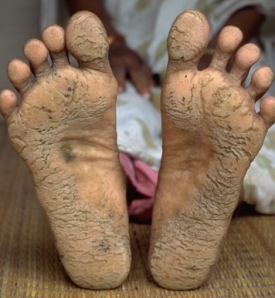Water turns ‘killer’
Even birds & rats hit in Bihar villages
Alomit
Cell-phones are adding fuel to the fire. It has been observed that 60 to 70 per cent villagers do not get proper sleep. Even birds, animals and insects could not escape the cell phone radiations. Scientific research, conducted by Prof. AK Tewari of Lala Lajpat Rai Medical College, Meiruth, has found that even birds have been affected. DNA of rats has been hit and eggs have low sperm counts and get destroyed. Bird population is falling. Bees forget their routs and produce less honey, the studies conducted by the professor has revealed. Bihar is facing identical problems, albeit no scientific study has been undertaken so far. Fast deforestation is there to complete dark circle.
And to cap it all, majority of districts have no proper laboratory facilities to test the drinking water and other things. Another important factor that has emerged is that almost all affected villages are situated on the either sides of the Ganga River. Experts alone would say if the contamination of underground water has something to do with the heavily polluted Ganga. And, if this scourge is born out of changing climatic changes in the world, why has nature chosen Bihar to punish its people?
Meanwhile, over two dozen babies in several villages of Bhojpur district have been born blind in the past three months mainly because their families consume groundwater containing alarming levels of arsenic. No reports are available so far to confirm or deny if this unusual phenomenon is limited to only Bhojpur district or has been taking its toll in other districts of Bihar. The state government has, however, initiated steps to test underground water in other districts of the state. Health Minister Nand Kishore Yadav also has confirmed the cases of blindness in newborns in arsenic-affected villages in Bhojpur but hastened to add that the cause of blindness was not known.
Though more than 16 districts have reported arsenic contamination of groundwater, Bhojpur, with 1,861 parts per billion (ppb) against the World Health Organization’s limit of 50 ppb, tops the list. It is for the first time that blindness at birth has been attributed to arsenic contamination, though doctors say that people using contaminated groundwater in affected areas suffer from cancer of the intestines, liver, kidneys and bladder and that bone deformity, gangrene and skin disorders are common. Arsenic is an odourless and tasteless semi-metal element which occurs naturally in the environment.
Dr S.K. Kedia, an eye specialist in Ara, who first examined these cases, said visual disability was found in both male and female children coming for examination from interior villages of the district. “The villages of Bhaluipur, Barahra, Bihia, Shahpur and Sandesh seem to be the most affected”, Dr Kedia said and added “90 per cent of the affected newborns were from poor families. These families fetch drinking water mostly from community hand pumps.
Dr Kedia has no doubt that “the cases are due to arsenic contamination, though it may need several micro-tests to firmly establish the cause”. Bhojpur Civil Surgeon Dr K.K. Labh admitted having received reports of 27 such cases but expressed doubts about blindness being caused by arsenic contamination of groundwater alone. “The impact of electromagnetic waves from cell-phone towers, presence of lead in drinking water sources, non-judicious medication by expectant mothers and environmental pollution could also lead to blindness”, he said. Sometimes it also occurs as a by-product of agriculture and industry due to heavy use of pesticides and insecticides or untreated effluent flows into water bodies.
Govt wakes up to the tragedy
Meanwhile, the Bihar government has started steps to fight and pre-empt this scourge. PHED minister Ashwini Kumar Chobey said that arsenic treatment plants were being set up in ten districts at a cost of Rs 1,100 crore. He said this decision was taken after an examination of underground water of the districts, situated on both banks of the Ganga. It was found that 1,618 villages in 13 districts have arsenic beyond the permissible limit. He said that the districts having arsenic more than the permissible limit in its underground water are Buxar, Bhojpur, Patna, Saran, Vaishali, Samastipur, Begusarai, Khagaria, Katihar, Munger, Bhagalpur, Lakhisarai and Darbhanga, he said.
To provide them safe water, two sanitary wells in each of 838 worst arsenic-affected villages are being dug, as a short term measure, Choubey said and added so far, 575 sanitary wells have been constructed. The minister said the government had decided to use Ganga water to provide safe drinking water to 39 arsenic-affected villages of Bhojpur district. The minister said the government sanctioned the multi-village scheme for 130 arsenic-affected hamlets in Buxar, 25 villages in Patna district and 45 villages of Vaishali that would be completed during 2010-11.
The government has sanctioned a scheme of Rs 107.17 crore for supply of drinking water using ‘upper bed’ water in the worst-affected 39 villages falling under Matihani and Baruauni blocks of Begusarai district. Similar steps have been undertaken to supply safe drinking water to 67 villages of Samastipur and 86 villages of Bhagalpur at a cost of Rs 82 crore and 78.29 crore respectively. He said besides the arsenic-hit villages, the government would launch a separate scheme for 8188 hamlets of 11 districts having excess fluoride in the water. The affected districts are Nalanda, Rohtas, Kaimur, Aurangabad, Gaya, Nawada, Bhagalpur, Banka, Munger, Jamui and Shiekhpura.


Leave a comment